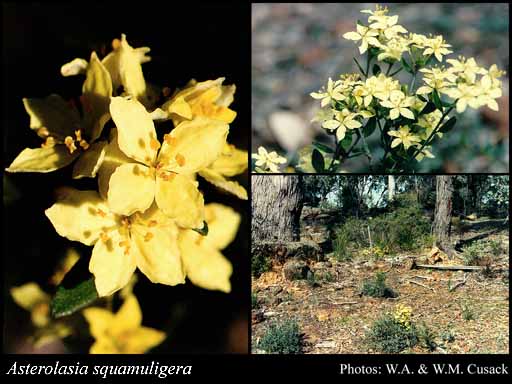- Reference
- Fl.Austral. 1:352 (1863)
- Conservation Code
- Not threatened
- Naturalised Status
- Native to Western Australia
- Name Status
- Current
Erect, spreading shrub, 0.15-1 m high. Fl. yellow/yellow-cream, Aug to Nov. Sandy clay or loam, gravelly lateritic soils. Hilltops, flats.

Scientific Description
Shrub, spines absent; branchlets smooth, without distinct raised glands, +/- cylindrical in cross-section, covered in hairs or scales, the hairs stellate (star-shaped). Leaves alternate, simple, 3-16 mm long, 2-6 mm wide, flat, the margins flat, smooth, without distinct raised glands, covered in hairs or scales, with stellate (star shaped) hairs; stipular excrescences absent. Flowers in axillary umbels or in terminal umbels; pedicels 8-10.5 mm long; calyx minute or absent, smooth, without distinct raised glands; corolla yellow, petals five, 8-9 mm long, valvate (not overlapping), free, lepidote (with scales); stamens numerous (more than twice as many as petals), 3.5-4 mm long, smooth, glabrous; anthers 1 mm long, without an appendage, glabrous. Flowers in August, September, October and November. Occurs in the South-West Botanical Province, in the Avon Wheatbelt, Jarrah Forest, Mallee and Warren IBRA region(s).
Distribution
- IBRA Regions
- Avon Wheatbelt, Jarrah Forest, Mallee, Warren.
- IBRA Subregions
- Katanning, Northern Jarrah Forest, Southern Jarrah Forest, Warren, Western Mallee.
- Local Government Areas (LGAs)
- Augusta Margaret River, Beverley, Brookton, Cranbrook, Cuballing, Denmark, Dumbleyung, Kent, Kojonup, Manjimup, Nannup, Narrogin, Pingelly, Plantagenet, West Arthur, Williams, York.